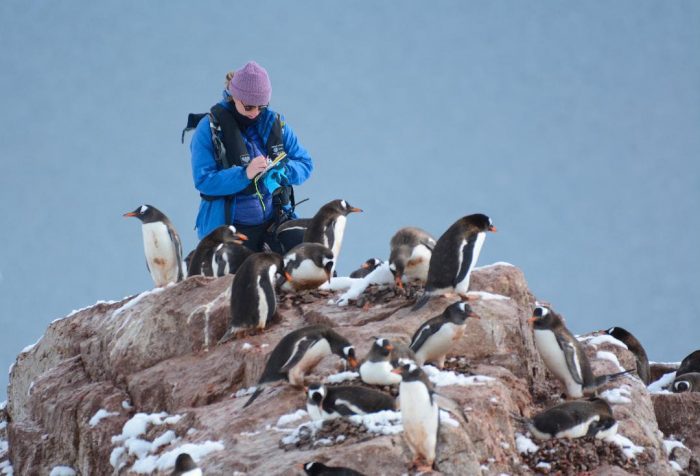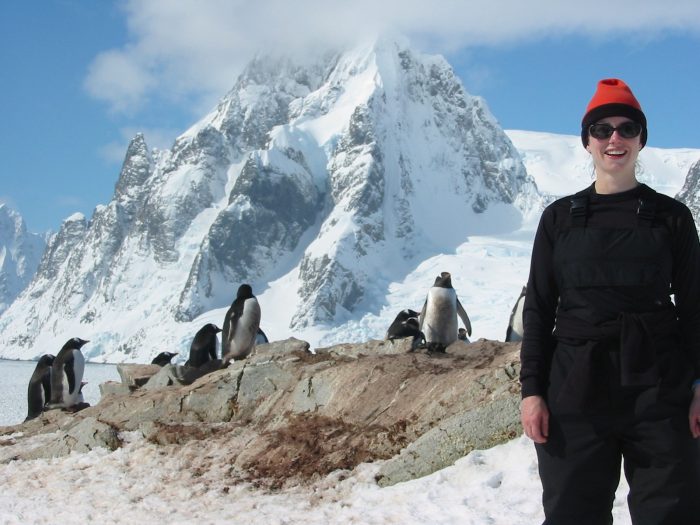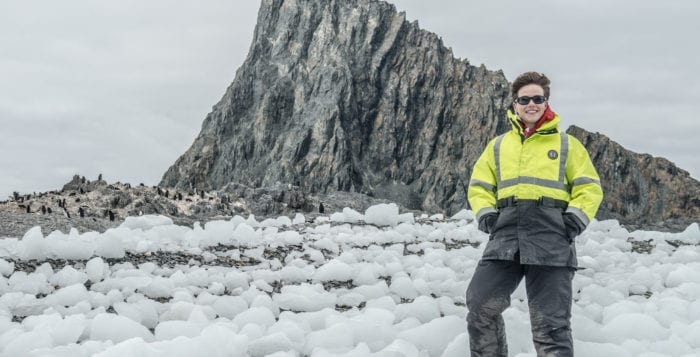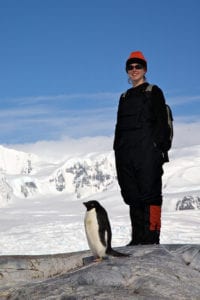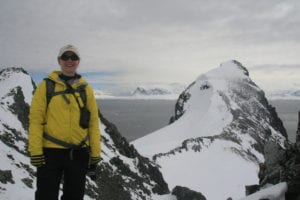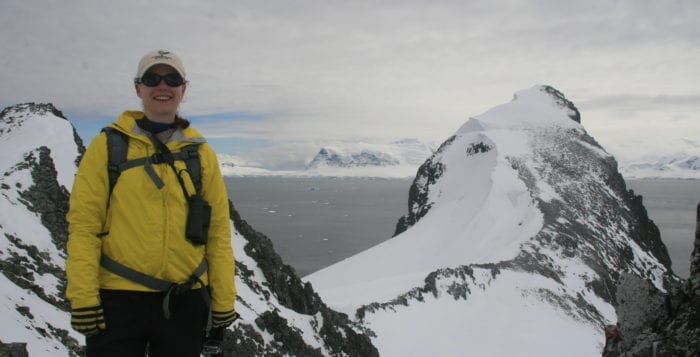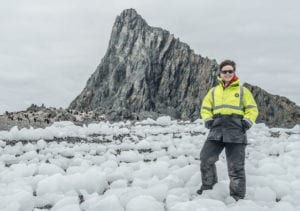By Daniel Dunaief
Humans may have nothing on penguins when it comes to viral marketing. Almost immediately after the Covid pandemic shut down tourism in parts of Antarctica, some gentoo penguins likely altered their choice of nesting sites.
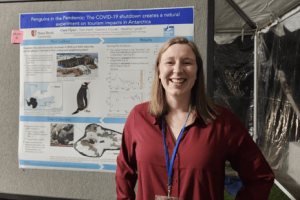
As if the penguins got an avian email alert indicating that tourists eager to send a post card from the only post office in Antarctica weren’t coming, these flightless birds quickly divvied up desirable real estate, which, for a gentoo penguin, means bare rock on which they make nests out of pebbles.
“Antarctica is seen as a mostly pristine place where humans have very little impact,” said Clare Flynn, a PhD student in the lab of Heather Lynch, the Institute for Advanced Computational Sciences Endowed Chair for Ecology & Evolution at Stony Brook University.
Flynn used a combination of ground counts from researchers and drone footage to tally the nests during the Covid years. Based on these numbers, she concluded that tourism has been “depressing the population sizes at Port Lockroy” and nearby Jougla Point.
The study suggests that even limited human visits to remote locations can alter decisions by wildlife, affecting the kind of reproductive choices that could, over time and with greater numbers of people coming, affect population sizes.
Pomona College Biology Professor Nina Karnovsky, who is an undergraduate thesis advisor and mentor for Flynn but didn’t participate in this research, suggested that this kind of analysis highlights the need for greater awareness of human influence.
“It shows that people even visiting the colony can have impacts,” Karnovsky said. “Tourism is a double-edged sword. You want people to experience Antarctica and see how precious life there is.” At the same time, researchers don’t want any such visits to have negative side effects.
Nest numbers
The number of penguin nests in Port Lockroy surged to 978 in the 2021/ 2022 breeding season. That is considerably higher than the 535 nesting pairs in the 2018/2019 season, according to data compiled and analyzed by Flynn. What’s more, when the post office returned to normal operations, bringing back tourists in 2022 and 2023, the nest number at Port Lockroy returned to its earlier levels, at 529.
The overall number of nesting gentoo penguins didn’t change dramatically in a cluster of gentoo penguin colonies around Wiencke Island during Covid, as many of these birds likely shifted their breeding locations from nearby sites that don’t have as much human activity, such as Damoy Point.
“It’s shocking how quickly [the changed nesting sites] happened,” Flynn said, occurring over the course of two years, not generations. “Tourism is just ramping up when the penguins are choosing nesting sites.” The shifting nest sites accounted for most of the increase in Port Lockroy and Jougla Point. Some of the gentoo penguins who may have skipped a breeding season, however, also might have decided to give it a go amid the pandemic closure.
Post office attraction
Flynn and Lynch have a few theories about what caused these nesting patterns.
Flynn suggested the nesting sites at Damoy Point and Dorian Beacon, where the number of nesting colonies declined during the lockdown, may have been close to carrying capacity, which means that prospective penguin parents found the equivalent of No Vacancy signs when they searched for places to build their nest.
Sites near the post office were not at carrying capacity prior to the pandemic. From visual inspection of the drone images, these sites had available bare rock, which is a limiting factor for gentoo penguins.
Flynn believes that pedestrian traffic may have dissuaded penguins from creating nests.
Human disturbance
Boat traffic may also be dissuading gentoo penguins from nesting. While there is a limit to the number of people who can land at any given time, people often cruise around the area in zodiacs, which increases the noise and could create a physical barrier for swimming penguins.
Last month, Lynch brought Flynn’s analysis of nesting numbers during the pandemic to the Antarctic Treaty Consultative Meeting in Finland. Policy makers are considering implementing a no-wake zone in Port Lockroy harbor as a first step to reduce disturbance.
While the number of nests typically varies by year at these sites, the dramatic increases and decreases lie outside that normal range, Flynn said. She called the numbers “eye popping,” as Port Lockroy had the largest population size ever recorded in 2021/ 2022 and Jougla Point saw the largest population size in 2021/2022 in over 20 years. Damoy Point and Dorian Beacon, by contrast, had huge drops.
Understanding the effects of tourism is becoming increasingly important, particularly as the appetite for travel to this area increases.
While gentoo penguins are doing well overall, an increase in the kind of tourism that exists at Port Lockroy could affect their breeding success.
“We need to understand how increasing levels of tourism affect these species so that the effects in conjunction with climate change effects don’t cause a disaster” for several penguin species, Flynn added.
Rewarding pivot
Flynn hadn’t intended to study the effects of Covid on the gentoo penguin. Instead, she was using drone images to identify whether penguins nested in the same place from one year to the next.
While Flynn was annotating images from 2018 through 2021, Lynch noticed the changes at Port Lockroy during those years. After Flynn took a deeper dive into the numbers, she made a new poster just one week before presenting her results at the Pacific Seabird Group annual meeting in February.
The “exhausting” effort, as Flynn put it, paid off, as she won runner up honors for best PhD poster at the conference. She has since sent the results out to Biological Conservation for publication.
Ecology spark
Flynn grew up near Baltimore and attended Pomona College, where she anticipated exploring her interest in math. She switched her focus to ecology. An ecology and evolution class she took with Karnovsky cemented her decision and brought her into the world of seabirds.
Karnovsky recalled how Flynn “loved collecting data,” which, in Southern California is “not a walk in the park, literally.” Flynn had to contend with cactus and poison ivy on an owl project.
Karnovsky believes her former student could “go on and do great things in this field.”
At one point about five years ago, Karnovsky told Flynn she might “go to Antarctica one day to study penguins,” Flynn recalled. At the time, Flynn thought the idea sounded “crazy.”
Karnovsky’s suggestion about Flynn’s future was less crazy than it was prescient.
When she’s not following her research calling, Flynn enjoys following recipes. She makes baked goods and is particularly fond of a blueberry muffin recipe she found in Bon Appétit magazine. Instead of putting in too many blueberry, which sink in the muffin, she makes a blueberry compote and sprinkles lemon zest sugar on top.
As for her future, Flynn hasn’t decided on a post PhD plan. This could include becoming a professor or pursuing a data science career.
“I could see her becoming a really wonderful professor because she also sees mentoring as really important,” Karnovsky said.

